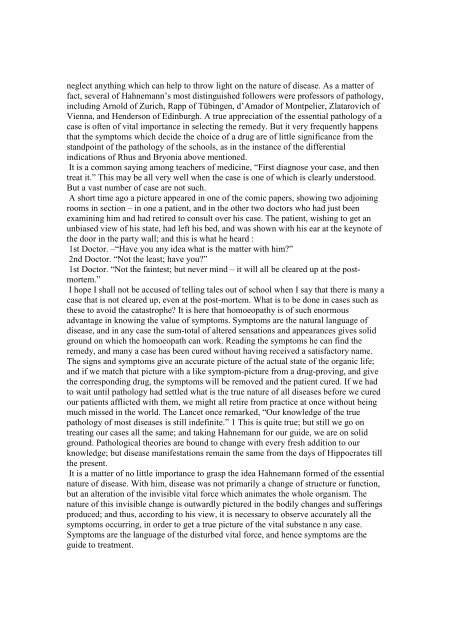CLARKE JH, Homoeopathy Explained - Classical Homeopathy Online
CLARKE JH, Homoeopathy Explained - Classical Homeopathy Online
CLARKE JH, Homoeopathy Explained - Classical Homeopathy Online
Create successful ePaper yourself
Turn your PDF publications into a flip-book with our unique Google optimized e-Paper software.
neglect anything which can help to throw light on the nature of disease. As a matter of<br />
fact, several of Hahnemann’s most distinguished followers were professors of pathology,<br />
including Arnold of Zurich, Rapp of Tübingen, d’Amador of Montpelier, Zlatarovich of<br />
Vienna, and Henderson of Edinburgh. A true appreciation of the essential pathology of a<br />
case is often of vital importance in selecting the remedy. But it very frequently happens<br />
that the symptoms which decide the choice of a drug are of little significance from the<br />
standpoint of the pathology of the schools, as in the instance of the differential<br />
indications of Rhus and Bryonia above mentioned.<br />
It is a common saying among teachers of medicine, “First diagnose your case, and then<br />
treat it.” This may be all very well when the case is one of which is clearly understood.<br />
But a vast number of case are not such.<br />
A short time ago a picture appeared in one of the comic papers, showing two adjoining<br />
rooms in section – in one a patient, and in the other two doctors who had just been<br />
examining him and had retired to consult over his case. The patient, wishing to get an<br />
unbiased view of his state, had left his bed, and was shown with his ear at the keynote of<br />
the door in the party wall; and this is what he heard :<br />
1st Doctor. –“Have you any idea what is the matter with him?”<br />
2nd Doctor. “Not the least; have you?”<br />
1st Doctor. “Not the faintest; but never mind – it will all be cleared up at the postmortem.”<br />
I hope I shall not be accused of telling tales out of school when I say that there is many a<br />
case that is not cleared up, even at the post-mortem. What is to be done in cases such as<br />
these to avoid the catastrophe? It is here that homoeopathy is of such enormous<br />
advantage in knowing the value of symptoms. Symptoms are the natural language of<br />
disease, and in any case the sum-total of altered sensations and appearances gives solid<br />
ground on which the homoeopath can work. Reading the symptoms he can find the<br />
remedy, and many a case has been cured without having received a satisfactory name.<br />
The signs and symptoms give an accurate picture of the actual state of the organic life;<br />
and if we match that picture with a like symptom-picture from a drug-proving, and give<br />
the corresponding drug, the symptoms will be removed and the patient cured. If we had<br />
to wait until pathology had settled what is the true nature of all diseases before we cured<br />
our patients afflicted with them, we might all retire from practice at once without being<br />
much missed in the world. The Lancet once remarked, “Our knowledge of the true<br />
pathology of most diseases is still indefinite.” 1 This is quite true; but still we go on<br />
treating our cases all the same; and taking Hahnemann for our guide, we are on solid<br />
ground. Pathological theories are bound to change with every fresh addition to our<br />
knowledge; but disease manifestations remain the same from the days of Hippocrates till<br />
the present.<br />
It is a matter of no little importance to grasp the idea Hahnemann formed of the essential<br />
nature of disease. With him, disease was not primarily a change of structure or function,<br />
but an alteration of the invisible vital force which animates the whole organism. The<br />
nature of this invisible change is outwardly pictured in the bodily changes and sufferings<br />
produced; and thus, according to his view, it is necessary to observe accurately all the<br />
symptoms occurring, in order to get a true picture of the vital substance n any case.<br />
Symptoms are the language of the disturbed vital force, and hence symptoms are the<br />
guide to treatment.
















